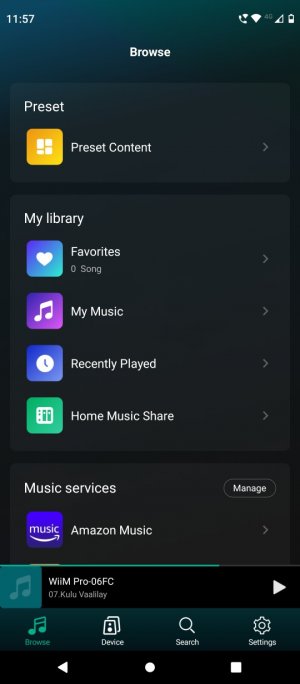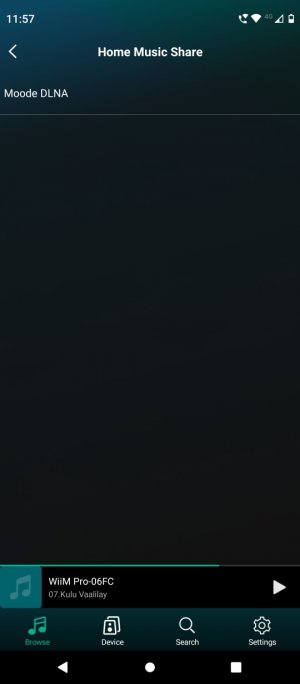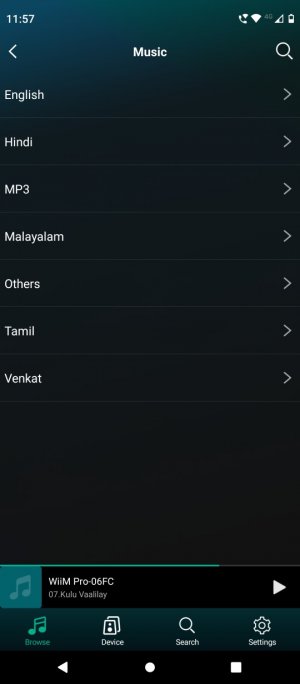Since sound quality etc. are subjective and umpteen reviews are available online, this write-up/review will be more about the feature set of WiiM-Pro.
Setting up the WiiM Pro is a breeze. You can use either wifi or ethernet, but ethernet is recommended for best performance.
Hardware Features:
Audio Inputs: Toslink, Network, Line in, Bluetooth
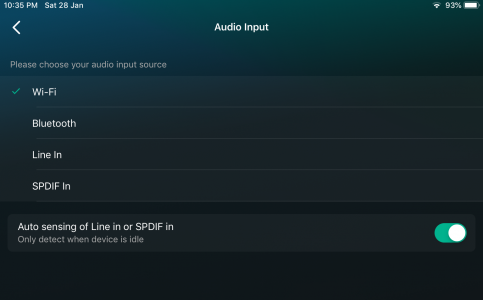 Audio Outputs: Toslink, Coaxial, Analogue, Bluetooth
Audio Outputs: Toslink, Coaxial, Analogue, Bluetooth
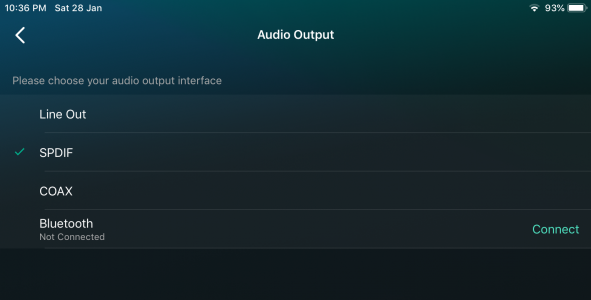 Software Features:
Software Features:
The WiiM pro hardware can be controlled from the WiiM Home app available for both Apple and Android devices (both phones and tablets).
A beta version of the app is also available for Windows PCs and Mac, but not yet fully functional.
WiiM Home app
WiiM Home app is the nerve center for controlling the WiiM pro device.
It includes a built-in player which supports playback of files up to 24bits, 192khz, so DSD files are still unsupported.
In effect it acts as a full featured wifi-based remote control for using the device.
The app fully controls all the software and hardware features of the device like selecting inputs, outputs, setting output resolution, controlling volume, enabling equalizer, editing streaming services etc.
Features of WiiM pro in unison with the WiiM Home app:
Playback of local files
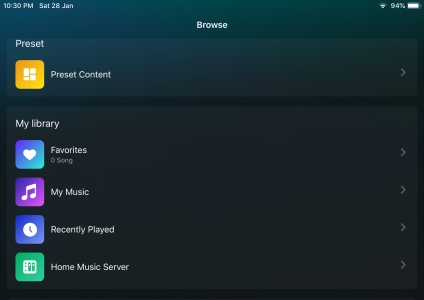 It offers Digital toslink (optical input), home media server (DLNA) (Samba will be implemented in future firmware) support, Chromecast, Bluetooth and analogue inputs for playback of personal music collection and network streams.
It offers Digital toslink (optical input), home media server (DLNA) (Samba will be implemented in future firmware) support, Chromecast, Bluetooth and analogue inputs for playback of personal music collection and network streams.
1. Direct playback from CD player or any other media player like raspberry pi (transport) that has optical output, or using a spdif converter if the transport only has USB/coax connectors.
2. Playback of music files stored in the device in which the App is installed.
3. Direct playback from any media server on the same network which could be a NAS, PC or even a router with built-in media server option. As of now SMB is not supported, but will be implemented soon with a firmware upgrade. Once SMB is supported it will throw-up lots more options.
If you have raspberry-pi based system, then it can be converted into a media server.
4. Playback from analogue sources like a cassette player, radio or even a turntable using its analogue inputs.
5. Playback of local files via Chromecast using music software players like JRiver, VLC or by running a full-fledged server like plex
6. Playback of local files via Bluetooth
7. If you have Apple Devices, you can use Airplay
Playback from Streaming services
The WiiM Pro has inbuilt APIs for many streaming services like Amazon Music, Spotify, Deezer, Napster, Tidal, Quboz to name a few. You can directly play if you have account with these streaming services.
This is possibly the best feature of this devise.
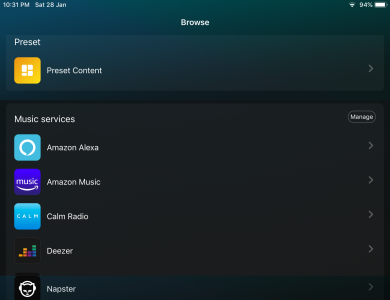 Playback from Open Network Streams
Playback from Open Network Streams
Another fantastic feature is native playback of all radio streams
You can directly key-in the URL of any streaming service or internet radio stations to playback from within the WiiM Player inside WiiM Home app.
You can add unlimited number of streams (have to add the links only once) and it gets stored for playback at anytime in the future.
Radio Paradise is a popular 24x7 streaming service that is already included in the app
Alexa, Siri or Google Voice can be used to control WiiM Pro to play music, listen to news, or your favorite podcast with voice assistants from phone, HomePod, Echo or Google Home devices. Automate WiiM Pro with other smart home devices by creating routines in the Alexa App, Apple Home or Google Home App.
Hardware Settings:
1. Use the internal volume control or defeat it
2. Set resolution for spdif outputs
3. Enable/Disable Chromecast
4. Audio sync if you use multiple WiiM devices
5. Set EQ and enable/disable it
6. Enable/Disable MQA
7. Enable mono mode if you use a single speaker
8. Choose audio input (Wifi, line in, spdif, Bluetooth)
9. Choose audio output (spdif, coaxial, line out, Bluetooth)
10. The volume + and – buttons can be reassigned as ‘previous track’ and ‘next track’. This is useful if you do not use the internal volume control
Sound Quality and Ease of Use:
1. The WiiM Home app is versatile, aesthetically designed, but simple and very easy to use.
2. The digital output is super good and will not be limiting factor in your remaining chain.
3. Built-in DAC is quite capable and WiiM Pro can be used as DAC cum preamp or plainly as a DAC if you have a dedicated pre or an integrated amp. If you have invested in a good DAC, then WiiM can be used a dedicated transport.
4.The device runs on 5 volts with current requirement of just 2 amps. So, any decent wall wart will be enough. To keep noise floor low, you may use a power bank or an LPS.
4. A dumb feature is that when switching outputs, the playback stops and we have to again pick and choose the file. I plan to report this in the forum and hope it is fixed via a firmware.
5.
DSD files are not supported and the only way to play them is with an external player like USB Audio Player, jRiver, foobar etc via Chormecast or Airplay. But as the device by itself is limited to 24/192, DSD files will not be played bit-perfect and will be downscaled to PCM.
I think I have covered most of the features and would summarize as under:
1. It is a perfect solution for those who use streaming services a lot or plan to add it in the future as it supports all major service providers with API integration. It means, you will get bit perfect playback and limitation if any will only be your network. So I suggest to go with ethernet instead of wifi.
2. Since it is a full-fledged server with in-built DAC and volume control, it can be a single box solution for those using active speakers or power amps. Those having integrated amps or dedicated preamp, it can used as a streamer-cum-DAC.
3. it supports both digital and analogue sources, so those with turntables and cassette players can also integrated it into their chain for a combo of digital and analogue sources.
4. Though its Bluetooth does not support aptx and higher codecs, the same can be used for casual listening.
5. As it also supports Bluetooth output, one can directly use their Bluetooth headphones or Bluetooth speakers with it.
